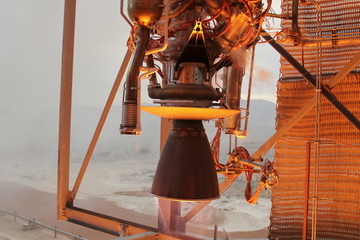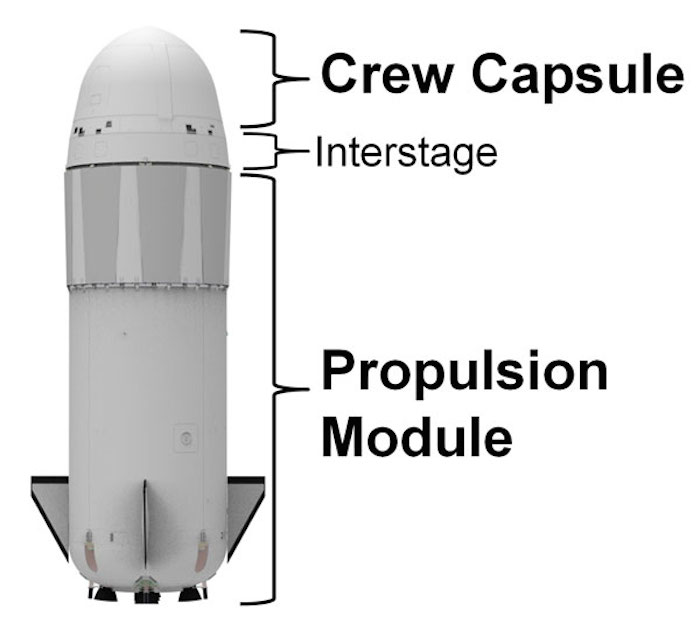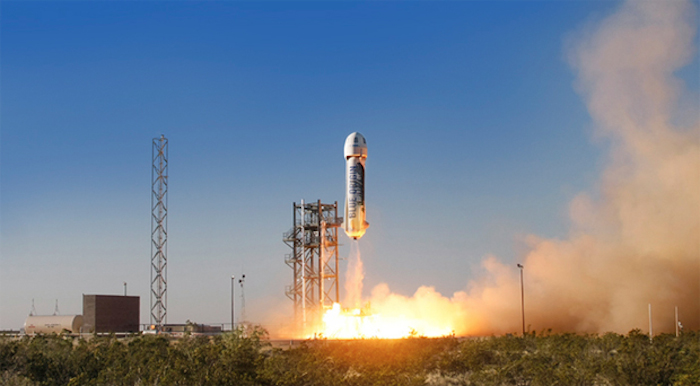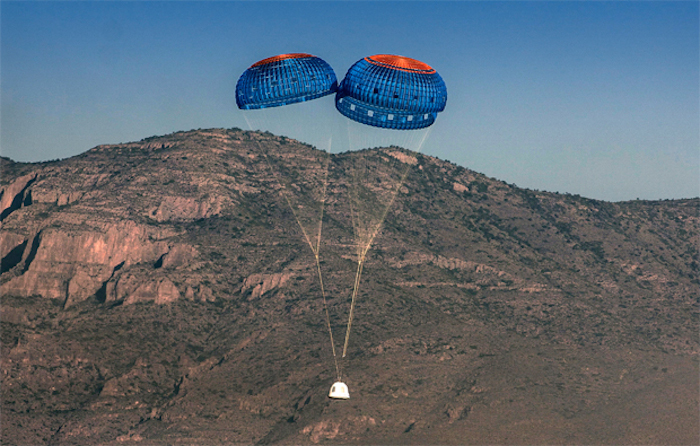.
8.04.2015

Blue Origin's BE-3 rocket engine undergoes acceptance testing, generating its maximum 110,000-lbs of thrust, at the company’s facility in West Texas.
.
Blue Origin, the secretive private spaceflight company founded by Amazon CEO Jeff Bezos, will begin suborbital flight tests this year of an innovative new spaceship — a milestone made possible by the firm's rocket engine success.
Blue Origin president Rob Meyerson told reporters today (April 7) that the company will fly unmanned suborbital tests of its New Shepard spacecraft later in 2015. The shakedown cruises are aimed at testing the performance and reusability of the commercial launch system's BE-3 rocket engine, which Blue Origin has cleared for suborbital flight.
"We're not releasing a flight date yet, but it will be later this year," Meyerson said in a teleconference. "It's soon."
The New Shepard spacecraft is designed to launch a crew capsule carrying at least three astronauts or passengers on suborbital flights that reach over 62 miles (100 kilometers) in altitude — the boundary of space, Meyerson said. A reusable booster powered by Blue Origin's BE-3 rocket engine will launch the spacecraft from the company's West Texas proving grounds, and then return to make a land-based landing.
Ultimately, Blue Origin aims to fly paying passengers and researchers on round trips to suborbital space, though Meyerson said manned flights on New Shepard are still several years away. First, the spacecraft and its BE-3 engine must pass a rigorous testing regime.
"They could go as quickly, in the early days, as on a monthly schedule — a month between tests," Meyerson said. "But we expect over the next couple of years to be flying regularly with the New Shepard vehicle."
To achieve a vertical launch and vertical landing for New Shepard, the BE-3 rocket engine is capable of throttling up to 110,000 pounds of thrust, as well as back down to 20,000 pounds of thrust, Meyerson said. The rocket engine is fueled by liquid hydrogen and liquid oxygen propellant and has passed 450 separate tests during its development.
.

A diagram of Blue Origin's New Shepard spacecraft for commercial spaceflight.
.
Meyerson added that Blue Origin will make the BE-3 engine commercially available for vehicles beyond its own New Shepard, which is named in honor of Alan Shepard, the first American to reach space. The company is also developing an upper-stage variant of the BE-3 engine, called the BE-3U, for use on a future orbital vehicle, he said.
Even as Blue Origin moves forward with the BE-3 engine and New Shepard spacecraft, the company is also making progress on its next rocket engine: the BE-4.
Jeff Bezos unveiled the BE-4 rocket engine last September during an event that announced a partnership between Blue Origin and the U.S.-based launch provider United Launch Alliance (ULA). Blue Origin is developing the BE-4 engine to power ULA's new rocket, the Next-Generation Launch Vehicle.
Meyerson said the first tests of a BE-4 rocket engine should begin in 2016 and be complete by 2017.



Since its founding in 2000, Blue Origin has worked so quietly to develop its manned spacecraft technology that it earned a reputation for secrecy while achieving major milestones, such as a stunning 2006 test flight of a prototype vertical-launch and -landing craft.
In more recent years, the company's orbital Space Vehicle project was one of several concepts competing under NASA's commercial crew program to fly astronauts to the International Space Station. (The agency selected Boeing and SpaceX space capsules last year) In 2011, Blue Origin reported the loss of a prototype launch vehicle, but followed that in 2012 with the announcement of a successful crew capsule launch escape system test.
Meyerson said he feels Blue Origin is doing more these days to keep the public informed on its private spaceflight progress.
"I hope you've seen we're being a little more open," Meyerson said. "These are high-risk tests. We're not going to invite the media to those early tests. As we get more experience with the vehicle, there's going to be many opportunities to have people there real-time to watch."
Quelle: SC
-
Update: 30.04.2015
.
Blue Origin launches sub-orbital New Shepard test flight
.
Blue Origin, a rocket engine and spacecraft development company owned by Amazon-founder Jeff Bezos, carried out an unpiloted maiden test flight of its New Shepard sub-orbital launch vehicle Wednesday, the company revealed early Thursday.
A dramatic video posted on Blue Origin's website (https://www.blueorigin.com/) showed the squat vertical-takeoff-and-landing New Shepard rocket being erected on a launch platform at the company's west Texas development facility followed by a brief countdown -- with Bezos looking on -- a smooth liftoff and a vertical climb to an altitude of 58 miles.
At that point, the dummy crew capsule separated from its booster and completed a parachute descent to Earth.
.

Blue Origin's New Shepard sub-orbital spacecraft climbs away from its West Texas launch site Wednesday, reaching an altitude of 58 miles in a dramatic unpiloted maiden test flight. Blue Origin, owned by Amazon-founder Jeff Bezos, hopes to begin launching space tourists, researchers and science payloads after an extensive series of test flights. (Credit: Blue Origin)
.
"Today we flew the first developmental test flight of our New Shepard space vehicle," Bezos said in a web posting. "Our 110,000-lbf thrust liquid hydrogen, liquid oxygen BE-3 engine worked flawlessly, powering New Shepard through Mach 3 to its planned test altitude of 307,000 feet.
"Guidance, navigation and control was nominal throughout max Q (maximum aerodynamic pressure) and all of ascent," he wrote. "The in-space separation of the crew capsule from the propulsion module was perfect. Any astronauts on board would have had a very nice journey into space and a smooth return."
The New Shepard is intended to be a fully reusable sub-orbital spacecraft with the booster flying itself to a vertical, rocket-powered landing after separation from the crew capsule. That phase of the test flight Wednesday was not successful, and the video did not include any shots of its descent.
"One of our goals is reusability, and unfortunately we didn’t get to recover the propulsion module because we lost pressure in our hydraulic system on descent," Bezos wrote. "Fortunately, we’ve already been in work for some time on an improved hydraulic system. Also, assembly of propulsion module serial numbers 2 and 3 is already underway -- we’ll be ready to fly again soon.
The New Shepard vehicle is built around the company's hydrogen-fueled BE-3 engine, which can be throttled through a wide range of power settings. The booster is designed to propel a crew/cargo capsule to altitudes above 62 miles, the generally accepted boundary of space. The capsule then separates for four to five minutes of weightlessness before falling back into the discernible atmosphere for a parachute descent.
The booster, meanwhile, is designed to carry out an autonomous powered descent, using the variable-throttle BE-3 engine to fly back to a vertical touchdown for refurbishment and reuse. After an extensive series of test flights, Blue Origin hopes to begin launching people, payloads or both as a commercial endeavor
.

A dummy crew capsule completes a parachute descent to Earth to close out the first test flight of Blue Origin’s New Shepard sub-orbital rocket. An attempt to recover the booster failed. (Credit: Blue Origin)
"New Shepard is designed to carry three or more astronauts up to sub-orbital space," Blue Origin President Rob Meyerson told reporters earlier this month. "We say 'three or more' because there are combinations of astronauts and science payloads. We believe the science payload market is going to be a big one as well."
Blue Origin will be competing with Richard Branson's Virgin Galactic, with its winged air-dropped rocketplane, and other companies vying to carry "space tourists" out of Earth's atmosphere for brief sub-orbital forays into space.
"We continue to be big fans of the vertical takeoff, vertical landing architecture," Bezos said. "We chose VTVL because it’s scalable to very large size. We’re already designing New Shepard’s sibling, her Very Big Brother -- an orbital launch vehicle that is many times New Shepard’s size and is powered by our 550,000-lbf thrust liquefied natural gas, liquid oxygen BE-4 engine."
The BE-4 has been selected by United Launch Alliance, a partnership between Boeing and Lockheed Martin, to power the company's new Vulcan rocket, the successor to the Atlas 5 and Delta 4 families of boosters.
Quelle: CBS News
-
FIRST DEVELOPMENTAL TEST FLIGHT OF NEW SHEPARD
Today we flew the first developmental test flight of our New Shepard space vehicle. Our 110,000-lbf thrust liquid hydrogen, liquid oxygen BE-3 engine worked flawlessly, powering New Shepard through Mach 3 to its planned test altitude of 307,000 feet. Guidance, navigation and control was nominal throughout max Q and all of ascent. The in-space separation of the crew capsule from the propulsion module was perfect. Any astronauts on board would have had a very nice journey into space and a smooth return.
In fact, if New Shepard had been a traditional expendable vehicle, this would have been a flawless first test flight. Of course one of our goals is reusability, and unfortunately we didn’t get to recover the propulsion module because we lost pressure in our hydraulic system on descent. Fortunately, we’ve already been in work for some time on an improved hydraulic system. Also, assembly of propulsion module serial numbers 2 and 3 is already underway – we’ll be ready to fly again soon.
We continue to be big fans of the vertical takeoff, vertical landing architecture. We chose VTVL because it’s scalable to very large size. We’re already designing New Shepard’s sibling, her Very Big Brother – an orbital launch vehicle that is many times New Shepard’s size and is powered by our 550,000-lbf thrust liquefied natural gas, liquid oxygen BE-4 engine.

The New Shepard crew capsule separates from the propulsion module and continues its ascent to 307,000 feet before returning to Earth for a classic landing under parachutes.
Quelle: Blue Origin
4239 Views
